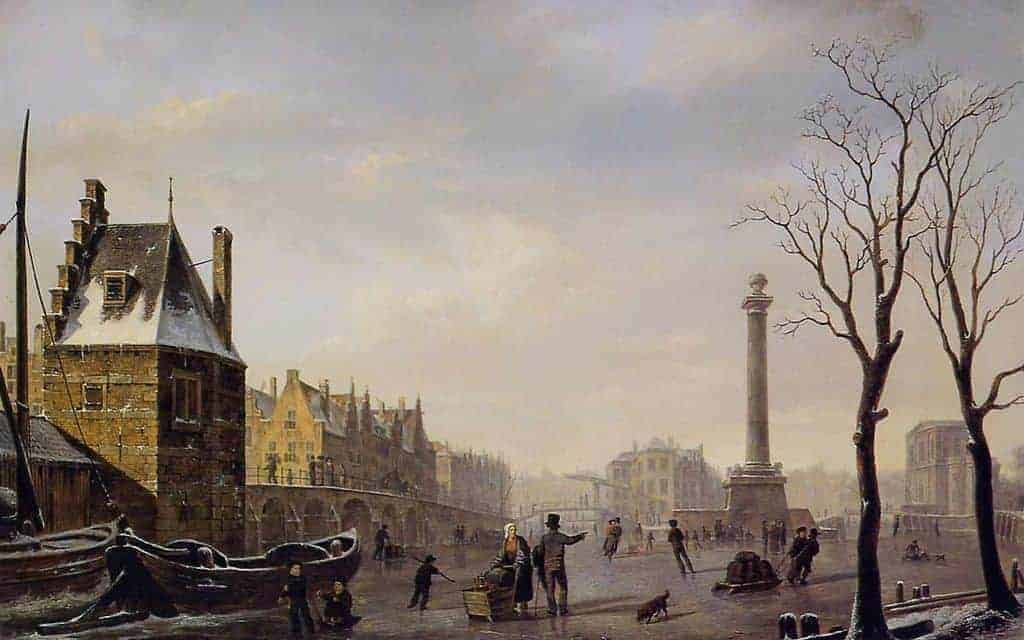Imagine ice floes on the Great Lakes in June. New York Harbor frozen over so that people could walk across it from Manhattan to Staten Island. In Europe, an Army from Sweden marching across the frozen strait of the Great Belt to attack their Danish enemies in Copenhagen. It happened during a period which is known as the Little Ice Age, affecting Europe and North America and to a lesser extent, South America and Asia. Climatologists and scientists cannot agree on when it began, nor its duration, with some claiming it lasted more than four centuries and others arguing for a shorter existence.
It produced shorter growing seasons which led to widespread famine. Famine in turn led to reduced populations and wars. The superstitious took to blaming the weather on witches and sorcery, and witchcraft trials in Europe became common. Europe began organized witch hunts during the Little Ice Age, despite the protestations of the Catholic Church that only God could control the weather. Across Christian Western Europe, Jews were blamed for the causes of reduced livestock, because of lack of fodder to feed animals. The food chain collapsed, leading to malnutrition, disease, death. In the British Isles and across coastal Europe, storms led to flooding which destroyed what crops did exist.

Here are ten facts about the Little Ice age for your consideration.

Marching across the sea
During the Little Ice Age the peoples of Europe and in the new colonies of North America went about their business, one of which was all too often war. In 1658, one of the coldest years ever recorded in Northern Europe, Sweden was at war with Poland, and the armies of Swedish King Charles X Gustav were unable to defeat a larger Polish Army. Charles was prepared to withdraw from Poland, but feared the effects of a defeat on his throne. King Frederick III of Denmark joined this Second Northern War, offering Charles an opportunity to disengage with the Poles and their allies and attack Denmark without returning to Sweden, saving face despite failing to defeat the Poles.
Charles marched his small but professional, well-equipped, and battle hardened army to Jutland, brushing aside Danish resistance. The Danes withdrew to the islands which are bordered by three belts connecting the Baltic Sea to the North Sea via the Kattegat. When the Swedes arrived at Jutland, the Danes believed themselves to be safely protected by the straits in their positions on the Islands of Funen, where the Little Belt separated them from Swedish troops, and on Zealand, separated from Funen by the Great Belt.
The extreme cold and pack ice in the belts made the idea of an attack using ship’s boats impossible. As the temperature continued to drop through December the ice floes in the belts began to merge and congeal. Engineers from Charles’s army suggested that the troops could march across the ice, including the cavalry and the horse drawn artillery. In the wee hours of January 30, 1658, the Swedish army marched across the frozen Little Belt, while the ice creaked and twisted beneath their feet. About 3,000 Danish defenders attempted to attack them on the ice but were easily defeated. With the Swedes safely on Funen a means of reaching the main Danish Army on Zealand was needed.
The 12,000 man Swedish Army waited on Funen while the engineers examined the Great Belt for the best means of crossing. They decided that the ice was thickest, and thus safest for the army, if it took a circular route to the north and east, a giant curve across the frozen sea, rather than marching directly across the strait. The King crossed with the cavalry on the night of February 5, and by February 8 the Swedish Army was on the island of Zealand, with the Danish capital of Copenhagen now under the threat of direct attack. By February 26 the Danes, unprepared for the attack which Charles had launched in the dead of winter, capitulated to their enemy.
Seawater freezes at a temperature of about 28.5 degrees Fahrenheit. The waters of the belts had to freeze to a depth of more than a foot to be able to support the weight of the Swedish artillery, supply wagons, mounted troops, and the rhythmic tread of several thousand men as they marched across the frozen straits. The Second Northern War was not the only incident of the climate affecting military affairs during the Little Ice Age, but it was one of the most dramatic. The Swedes crossed the Little Belt at a point where its width was just over three miles. The crossing of the Great Belt was several miles longer due to the circular route selected by the Swedish Engineers.

